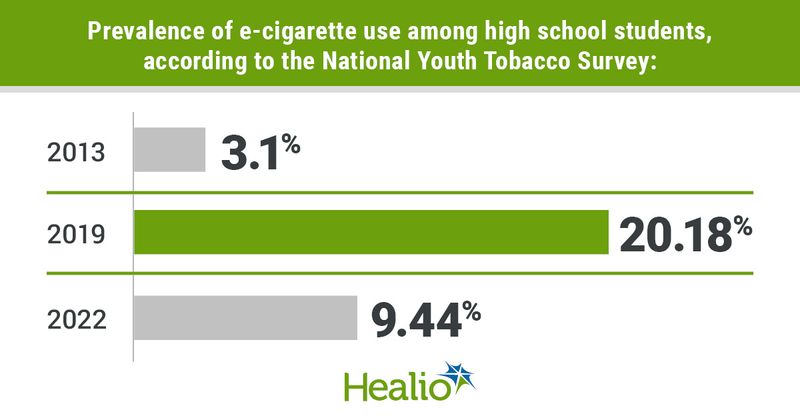Study: Youth e-cigarette use peaked in 2019
Key takeaways:
- The prevalence of e-cigarette use among youths peaked at around 20% in 2019.
- One author calls the demographic shifts “alarming.”
Use of e-cigarettes among youths in the United States peaked in 2019 and has declined in the years since, although not for all groups, a study showed.
Recent investigations have demonstrated that even restrictions placed by the FDA on e-cigarette flavors and products in 2020 have not dissuaded young consumers from using e-cigarettes, with sales surging to over 22 million units per month in 2022.

“Youth e-cigarette use in the United States is a pressing public health problem,” Delvon T. Mattingly, PhD, MS, assistant professor in the department of behavioral science at the University of Kentucky College of Medicine told Healio. “With this research, we aimed to increase understanding of trends in general youth e-cigarette use, as well as use in key demographic groups.”
Mattingly and colleagues studied 10 years of data from the CDC’s National Youth Tobacco Survey from 2013 to 2022, which included responses from more than 199,000 youths.
“With these data, we estimated the year-specific prevalence of e-cigarette use, as well as prevalence estimates specific to age, sex, and race and ethnicity categories,” Mattingly said. “Once we calculated these estimates for each year, then we observed trends over time and used 95% CIs to indicate whether prevalence has changed over the years.”
Among a cohort of 186,555 youths with complete information, e-cigarette use was 3.1% in 2013 and reached a peak of 20.18% in 2019 before falling to 9.44% in 2022. The researchers found that e-cigarette use prevalence in 2019 was high among Hispanic (18.64%) and non-Hispanic white (23.37%) youths, compared with non-Hispanic Black (13.32%) youths. From 2021 to 2022, the prevalence increased among Hispanic (5.78% to 8.51%) and non-Hispanic Black (4.23% to 8.04%) youths.
“The shifts in use patterns are alarming and warrant further investigation, such as continuing to monitor trends in prevalence and contributing to preventive efforts aimed at reducing e-cigarette use among youth populations,” Mattingly said. “These increases should not be overlooked.”
Mattingly hopes health care providers “recognize that e-cigarette use by youth is still common, even if not as common as it was a few years ago.”
“I hope for more detailed examinations of e-cigarette use prevalence by frequency and intensity of use, as well as ... whether youth are vaping nicotine, cannabis, some other substance, or simply flavorings,” Mattingly said. “These additional details, analyzed from a health disparity lens, will allow us to better understand which subpopulations of youth are at higher risk for nicotine dependence and other health consequences.”
